In his much anticipated follow-up to his Pulitzer-Prize winning Underground Railroad, Whitehead tells the story of life in a Florida reform “school” for boys, returning to the genre of historical fiction, but without the fantastical elements present in Underground Railroad. The Nickel Boys is a relatively short book—a quick read but far from a pleasant one.
The Nickel Boys is a fictionalized version of the story of Florida’s infamous Arthur G. Dozier School for Boys, in reality more of a penal institution than a school, which had opened in the Florida panhandle town of Marianna in 1900 and remained open until 2011. Run as a reform school by Florida’s state government, the Dozier school had for years been the subject of allegations that boys sent to the academy were systematically subjected to molestation, beatings, torture and even murder by employees and by guards with the knowledge of—and even under the direct supervision of—the “school’s” administrators. When the Florida Department of Law Enforcement finally began an investigation into these allegations in 2010, it was clear that the charges were true, and the U.S. Department of Justice initiated additional investigations in 2011. The University of South Florida began forensic studies of bodies found in scores of burial sites on the campus, revealing the broken bodies of boys who had been beaten to death. The university has determined that at least 81 boys died at the site.
For purposes of his novel, Whitehead has renamed the Dozier School the “Nickel Academy,” though he has kept its location in the Florida panhandle. His protagonist is a fictional boy named Elwood Curtis, an African-American teenager sent to the segregated school in 1964. Elwood is not a typical resident. Most of his fellow inmates, or I suppose I should say “students,” have been sent here for some petty crime or other, or because they’ve been deemed “incorrigible,” or they are indigent and have nowhere else to go, like orphans or wards of the state. Elwood is a model student, who is inspired by the speeches of Martin Luther King that he listens to repeatedly from a record his grandmother gave him, and whom his fellow students regard as a “goody-goody.” He lives with his grandmother, has always sought to be a “good citizen,” has a steady and responsible job, makes excellent grades in school so that his inspiring history teacher, Mr. Hill (a civil rights activist who recognizes Elwood’s standout mind and character) has recommended that he take college classes during his senior year of high school. When Elwood is walking to college one morning, excited for his first class in English literature, he accepts a ride from a black man in a Plymouth. But they are pulled over by the police, who arrest them for grand theft auto. Neither the fact that he was only a passenger nor his spotless previous record prevents the judge from sentencing him to time at the Nickel Academy.
Elwood sees the world as a meritocracy, in which people get what they earn and what they deserve, and so has always striven to do what is necessary to earn and merit life’s rewards. And that belief, along with Dr. King’s ringing rhetoric that he is as good as anyone else and that he lives in a just universe, governs, as well, his life at Nickel, at least at first. “He just had to keep doing what he’d always done: act right,” Elwood believes.
Those ideas are put to the test and found severely wanting in the meat grinder that is Nickel Academy. The system of merits and demerits by which Elwood believes he can work his way out of the school turns out to be a sham rendered subjectively and capriciously by the school’s house wardens. But more importantly, when Elwood instinctively tries to step in to prevent a group of bullies from beating up a young boy, he is taken from his bed in the middle of the night into what is essentially the school’s torture chamber, what the boys refer to as the White House, and is beaten into unconsciousness by the brutal superintendent Maynard Spencer. The beating lands Elwood in the infirmary for weeks, and tears his legs up in such a way that they will never heal. The beating not only harms him physically, but psychologically as well: Whitehead asserts it “had scarred him all over, not just his legs….It had weeviled deep into his personality.”
One close friend Elwood makes at the academy is a boy named Turner, who is far more skeptical about the system, and the world itself, than Elwood. Turner knows that in order to survive the brutalities of Nickel, one needs to keep one’s head down and “go along to get along.” Turner has figured out how to work the system, and survives by understanding what the white people in charge want. He is able to get Elwood an assignment with him to regularly leave the school along with a white guard for “social service” duties: These involve delivering groceries intended for the boys to local stores where shopkeepers will sell them for large profits, and doing chores like painting an old white woman’s gazebo free of charge. Thus the entire establishment profits off of the school, while the boys in the school are exploited and served barely edible food, and nobody wants to ask any questions about the school because it’s in everyone’s interest—or at least everyone’s who matters—to leave it alone.
As Elwood becomes more and more like Turner, he chides himself, lying awake at night and thinking that “In keeping his head down, … he fooled himself that he had prevailed. … In fact he had been ruined. He was like one of those Negroes Dr. King spoke of in his letter from jail, so complacent and sleepy after years of oppression that they had adjusted to it and learned to sleep in it as their only bed.” And accordingly he comes up with a plan to try to obtain justice one more time. Revealing what that is would be spoiler territory I won’t enter.
The last section of the book alternates between scenes from Nickel Academy in 1964 and later scenes from New York City ranging in time from 1968 to 2012. Among other things, we learn how impossible it is to transcend traumatic memories at Nickel, and how those experiences affected the boys’ subsequent lives. The Nickel boys, Whitehead writes, “could have been many things had they not been ruined by that place. Doctors who cure diseases or perform brain surgery, … [S]ure not all of them were geniuses … but they had been denied even the simple pleasure of being ordinary. Hobbled and handicapped before the race even began, never figuring out how to be normal.” The book ends with a jarring twist that that makes the book even more excruciating than it had seemed. If you’ve seen the new 2024 film version of the film, you may find the ending somewhat puzzling. But trust me, there is no ambiguity at all in the novel.
In an NPR interview, Whitehead said when he first read of the Dozier school in 2014, “It dawned on me, if there’s one place like this, there’s dozens and dozens. And where are those places? And what happens to the kids afterward? And immediately, I felt like I wanted to write about it.” Indeed, there were such schools all over the South, and in his acknowledgements he includes books about institutions in Arkansas as well as other states. This is a historical novel with a good deal of contemporary relevance. Whitehead had wanted to begin another book, but felt compelled, after the resurgence of America’s racist underbelly in recent politics, to deal with this story: The “concentration camps on the border,” according to NPR, led Whitehead to conclude about the Dozier story, “This speaks to a larger culture of impunity.”
The Nickel Boys does not appear on any of the original lists I looked st when I was building my list, because it was simply to recent. But it won 2019’s Kirkus Prize, and was a finalist for the National Book Critics Circle Award. And, deservedly, it was named on Chicago Tribune’s, Entertainment Weekly’s and Time magazine’s “Best Novels of the Decade” for the 2010s. On the New York Times’ Reader’s choice list of the 100 Best Books of the 21st Century, it was ranked as number 37. It also won Whitehead his second Pulitzer Prize for fiction. And of course it is here as book number 97 (alphabetically) on my own list of the “100 Most Lovable Novels in the English Language.”

